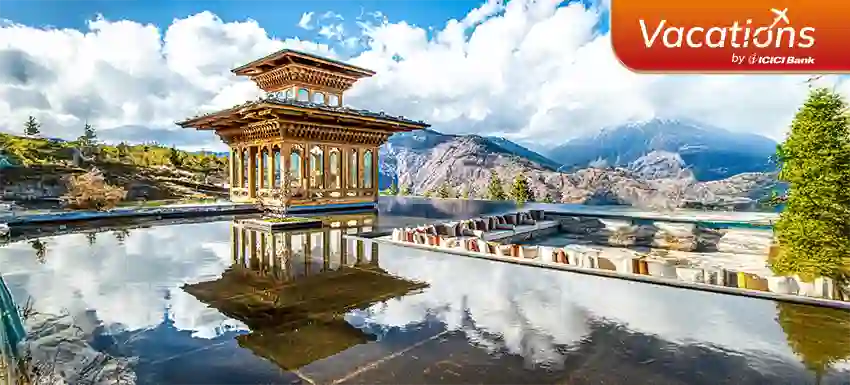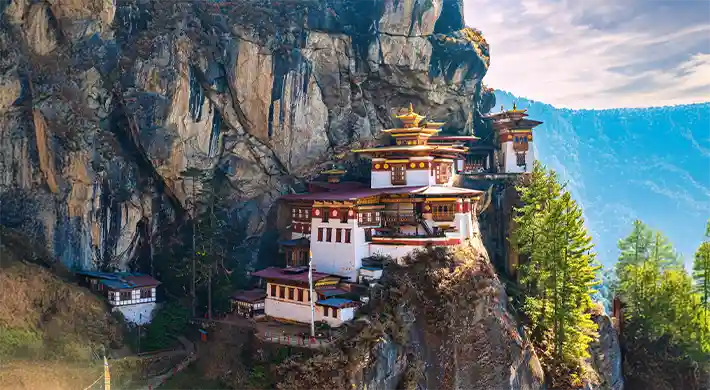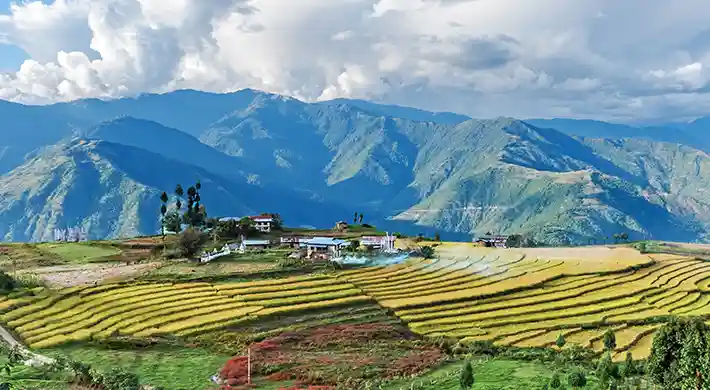THE
ORANGE
HUB
Bhutan Travel Magazine

Theme of the Month: Journey of Happiness
Happiness in Bhutan is not a pursuit — it is the air you breathe, the rhythm of prayer flags in the wind and the quiet smile of a monk at dawn.
Bhutan has long been celebrated as the ‘Land of Happiness’ not because life here is free of struggle but because joy is seen as something deeper than fleeting moments. Rooted in the philosophy of Gross National Happiness, Bhutan’s approach goes beyond economics — weaving together community, culture, spirituality and the natural world.
Travelling here is an invitation to redefine happiness for yourself. It’s not about checking off sights or snapping photos; it’s about walking slowly, listening closely and absorbing the stillness that envelops the valleys. In Bhutan, happiness feels less like an achievement and more like a practice — cultivated in the daily rituals of lighting butter lamps, tending fields or sharing a warm bowl of ema datshi with friends.
The country’s spirit comes alive through its vibrant festivals. Monks in swirling robes and locals in their finest kira and gho gather before dawn to witness sacred cham dances. The air is filled with the sound of drums, horns and the murmur of blessings. Later in the season, the Black-Necked Crane Festival honours the return of these graceful birds to the Phobjikha Valley reminding us that true happiness is inseparable from the cycles of nature.
In Bhutan, joy is not found at the end of the road — it is discovered step by step as you journey inward as much as outward.
Soul Trip: Travel as an Inner Ritual

Every journey begins outward but ripens inward. Festivals and rituals remind us that travel can be about more than sightseeing—it can be soul work.
To attend a Tshechu in Bhutan is not only to watch masked dances; it is to sit among villagers, monks and pilgrims who believe each gesture carries centuries of wisdom. To walk mountain paths is not only an exercise; it is to feel the earth steady your breath.
This is the gift of conscious travel: allowing the external world to mirror our internal one. The chime of a temple bell can echo the silence you seek within. A butter lamp flickering in the night can remind you of your own resilience.
When you treat travel as a ritual, every detail becomes meaningful. Meals are offerings, landscapes are teachers and encounters are blessings. The road becomes not just a route between places but a thread weaving together the visible and invisible.
This month, may you walk as though each step were a prayer—and let the world answer back.
Destination Focus: Bhutan – The Happiest Country

A Kingdom at the Roof of the World
Tucked high in the eastern Himalayas, Bhutan is often called the ‘Last Shangri-La.’ It is a landlocked kingdom bordered by India and China yet it feels like a world apart. With just over 770,000 people, it is one of the smallest countries in Asia—but its cultural, spiritual and environmental richness makes it vast in significance.
Geography & Natural Beauty
Bhutan’s terrain is dramatic—steep mountains, lush valleys, fast-flowing rivers and endless forests. More than 70% of the country is covered in forests, making it not just carbon-neutral but carbon-negative. In October, the skies are crystal clear, revealing views of towering Himalayan peaks such as Jomolhari and Gangkhar Puensum (the highest unclimbed mountain in the world).
Autumn is one of the best times to visit Bhutan. The monsoon rains have washed the land clean, rice fields are golden with harvest and the weather is crisp yet pleasant—perfect for hiking, festivals and photography.
History & Culture
Bhutan’s story is one of resilience and preservation. Buddhism has shaped its spiritual and cultural life for over a millennium. The iconic monasteries—such as Paro Taktsang (Tiger’s Nest), perched on a cliff—are not just architectural wonders but living centres of prayer. The country famously measures its success not by Gross Domestic Product (GDP) but by Gross National Happiness (GNH), emphasising well-being, cultural integrity and environmental balance.
October is also the festival season, when Bhutan’s vibrant culture comes alive in masked dances, music and rituals. The Thimphu Tshechu, one of the grandest festivals, often falls in late September or early October, drawing locals in colourful dresses and visitors eager to witness centuries-old traditions.
Things to Do & See
Paro Taktsang (Tiger’s Nest Monastery): A must-see and a spiritual highlight. The trek is challenging but rewarding, with breathtaking views.
Thimphu: The capital city, blending tradition and modernity. Visit the Memorial Chorten, Tashichho Dzong and the bustling weekend market.
Punakha Dzong: Perhaps the most beautiful fortress in Bhutan, sitting at the confluence of two rivers.
Dochula Pass: On clear days, it offers panoramic views of the Himalayas, framed by 108 chortens (stupas).
Phobjikha Valley: Known for its glacial valley and as the winter home of the endangered black-necked cranes, which usually arrive by late October.
Festivals (Tshechus): The Thimphu Tshechu and Gangtey Tshechu are especially worth attending this season.
Travel Practicalities
Best time to visit: September–November for festivals, clear skies and pleasant temperatures.
Visa: Not required for Indian travellers.
Daily Package System: Bhutan regulates tourism with a Sustainable Development Fee (SDF). Visitors must book through an approved operator, which ensures guided tours, accommodation, meals and transport.
Events in October: Harvest festivals, Thimphu Tshechu and excellent trekking conditions.
Bhutan is not just a destination. It’s an invitation—to slow down, to listen and to engage with a culture that has managed to protect its soul in a rapidly changing world.
Travel Smart: Festival Playbook

Arrive early: Reach festival grounds pre-dawn if you want a good seat. Locals often come hours before.
Dress in layers: Days can be sunny but mornings and evenings are crisp. Modest attire is a must.
Carry some cash: Useful for donations, snacks or offerings at temples.
Stay connected offline: Download maps and keep key details handy—WiFi can be patchy in valleys.
Protect your gear: Carry a lens cloth and rain cover; sudden mountain showers are common.
Learn a few words: ‘Kuzuzangpo la’ or ‘Tashi Delek’(hello), ‘Kadrinche la’ (thank you), ‘Log jay gay’ (see you again). Even simple phrases bring warm smiles.
A little preparation turns a festival from something you watch into something you feel part of.
Sustainable Travel Tip of the Month: Honouring Local Customs

Festivals in Bhutan are not staged—they are sacred traditions. Here’s how to engage with them responsibly:
Respect the sacred: Keep voices low, don’t block rituals and never turn your back on sacred dances.
Dress modestly: Cover shoulders and knees. A light scarf is useful for temples or festival grounds.
Follow local etiquette: Observe how Bhutanese families bow or sit; mirror their gestures with humility.
Support the community: Buy handicrafts, textiles or food from local vendors—it sustains families and traditions.
Be mindful with photos: Always ask before photographing people in prayer. A smile and a ‘May I?’ goes far.
Leave no trace: Carry your waste, refill bottles and keep festival grounds pristine.
When you travel with respect, festivals shift from being spectacles to shared experiences—a chance to honour culture, spirit and community while walking gently on sacred ground.
Scroll to top


